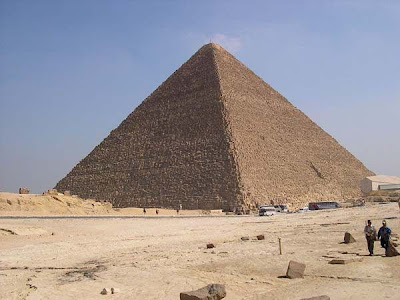In the northern pit, they found a stone ball and a piece of wood in the southern shaft was found a hook made of copper or bronze.
Both artifacts were brought to England, and registered the royal astronomer of Scotland.
Reported the discovery on Dec. 26, 1872, the magazine "Nature" published figure of these artifacts, and then they disappeared ...
In 1993, the search resulted in the British Museum, where they are today.
Part of the tree, discovered in the mines was not available until 2001, has not yet surfaced in the Museum Marischal, Aberdeen.
Although the last is sure that the piece of wood is among their collections, they have not yet determined its position among the finds.
In the mine, and later studied Gantenbrink, was also found fragments of a long piece of wood lying in the bend, which was very similar, the previously discovered in the northern mine in 1872.
In 1993, in connection with the remarkable discovery of a wave of new interest in the Great Pyramid. German robotics engineer Rudolf Gantenbrink hired to install ventilation systems inside the pyramid, received permission to design a robot to explore the mine within the Queen's Chamber. Unlike similar mines, coming from the King's Chamber,
These approximately 20-centimeter square of mine had no known destination, they do not lead to the surface of the pyramid. A detailed account of these studies, anyone can find on a personal site Gantenbrink: http://www.cheops.org/
The robot, named Upuat II (Upuaut II, the discoverer of ways) and equipped with lights, camera and a laser pointer, received excellent feedback from. Going up the Queen's Chamber southern shaft of the robot ran into a solid block of limestone, from which protruded two mysterious copper parts.
At Monday, September 16, 2002 at 8:00 pm Channel FOX (USA) has started the live broadcast of a new study of the southern shaft in the Queen's Chamber in the Pyramid of Khufu.
The two-hour prelude FOX / National Geographic on the Giza plateau was preceded by a moment when, finally, the new robot made it to the mysterious "door" and inserted into the drilled hole camera.
Was carried out painstaking preliminary work. To determine the length of the drill bit, it was necessary to first know the thickness of the limestone block using ultrasound. Dr. Hawass oversaw preparation, and then gave the command to drill so-called "door. "
With inimitable style and unconcealed satisfaction Dr. Hawass declared: "This is - another door, so even with a crack!"
A week later, Hawass pledged to continue the study in conjunction with the National Geographic Society.
September 23, 2002 in News reported that successfully explored northern shaft in the Great Pyramid. This mine, located in front of his South "sister" robot Gantenbrink could not inspect because of impassable last bend. The current team took into account the previous deficiencies in the design of the robot. Robot in 2002 could go round a bend on the floor moving as mine, and on the ceiling.
Secret Piramidy Heops
by Adil | 12:30 PM in cheops, egyptians, mysteries, passage, pyramid, secret of great pyramids, Secret Piramidy Heops, the great pyramids, the pyramids |



















